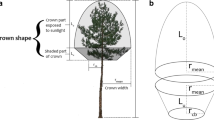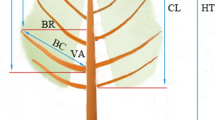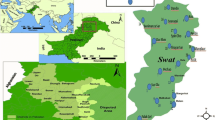Abstract
Unique woodlands of Dracaena cinnabari (DC) are at risk throughout most of their range (Socotra Island, Yemen) as a result of missing regeneration and overmaturity. Effective conservation measures depend on reliable predictions of future population dynamics, which depend on accurate data on current age structure. However, age determination of Dracaena sp. has long been a scientific challenge, because the common method of tree ring counts cannot be applied to this or to most other monocotyledonous trees. In the present study, the indirect method for crown age estimation proposed by Adolt and Pavlis (Trees 18:43–53, 2004) was further developed using a more appropriate statistical technique and an intuitive model formulation. This new technique is based on the relationship between the number of branching orders and the number of flowering events that result from a specific growth pattern. We used logistic regression to directly model annual flowering probability, the reciprocal value of which corresponds to the length of the interval between flowering events. Our methodology was applied to data sets collected at two ecologically distinct sites. In Firmihin, the time between flowering events decreases from 28 years between the first and second event to 10 years between the 25th and 26th event. The length of time between flower events in Skant, however, was estimated to be a constant value of 6.5 years. We propose the application of generalised mixed-effects models and methods of survey sampling to improve the accuracy of crown age estimation in DC. Our methodology may also be useful for age estimations of other tree species with similar growth patterns, such as Dracaena draco and Aloe dichotoma.






Similar content being viewed by others
References
Adolt R, Pavlis J (2004) Age structure and growth of Dracaena cinnabari populations on Socotra. Trees 18:43–53
Agresti A (2002) Categorial data analysis. Wiley, Hoboken
Barabesi L (2003) A Monte Carlo integration approach to Horvitz–Thompson estimation in replicated environmental designs. Int J Stat LXI:355–374
Bolker BM, Brooks ME, Clark CJ, Geange SW, Poulsen JR, Henry M, Stevens H, White JS (2008) Generalized linear mixed models: a practical guide for ecology and evolution. Trends Ecol Evol 24(3):127–135
Brienen RJW, Zuidema PA (2006) Lifetime growth patterns and ages of Bolivian rain forest trees obtained by tree ring analysis. J Ecol 94:481–493
Brienen RJW, Zuidema PA (2006) The use of tree rings in tropical forest management: projecting timber yields of four Bolivian tree species. For Ecol Manag 226:256–267
Brienen RJW, Zuidema PA, Martinez-Ramos M (2010) Attaining the canopy in dry and moist tropical forests: strong differences in tree growth trajectories reflect variation in growing conditions. Oecologia 163:485–496
Calama R, Montero G (2005) Multilevel linear mixed model for tree diameter increment in stone pine (Pinus pinea): a calibrating approach. Silva Fenn 39(1):37–54
Calama R, Montero G (2006) Stand and tree-level variability on stem form and tree volume in Pinus pinea L.: a mutilevel random components approach. Sist Recur For 15:24–41
Cochran GW (1977) Sampling Techniques. Wiley, Hoboken
Gregoire GT, Valentine TH (2008) Sampling strategies for natural resources and the environment. Chapman and Hall/CRC, Boca Raton. ISBN 978-1-58488-370
Habrova H (2004) Geobiocoenological differentiation as a tool for sustainable land-use of Socotra Island. Ekologia 23:47–57
Habrova H (2007) Climate of Soqotra with a view to rains. Tayf Soqotra Newslett 4:15–16
Habrova H, Cermak Z, Pavlis J (2009) Dragon’s blood tree threatened by overmaturity, not by extinction: dynamics of a Dracaena cinnabari woodland in the mountains of Soqotra. Biol Conserv 142:772–778
Heuret P, Barthelemy D, Guedon Y, Columier J, Tancre X (2002) Synchronization of growth, branching and flowering processes in the South American tropical tree Cecropia obtusa (cecropiaceae). Am J Bot 89(7):1180–1187
Hubalkova I (2011) Prediction of dragon’s blood tree (Dracaena cinnabari balf.) stand sample density on Soqotra Island (key study). J Landsc Ecol 4:5–20
Kral K, Pavlis J (2006) The first detailed land cover map of Socotra Island by Landsat/ETM+data. Int J Remote Sens 27(15):3239–3250
Lusk HC, Smith B (1998) Life history differences and tree species coexistence in an old-growth New Zealand rain forest. Ecology 79:795–806
Magdefrau K (1975) The age of large Dracaena specimens of Tenerife. Flora 164:347–357
Norton AD, Ogden J (1990) Problems with the use of tree rings in the study of forest population dynamics. In: Cook ER, Kairiukstis LA (eds) Methods of dendrochronology: applications in the environmental science. Kluwer, Dordrecht
Ogden J (1985) Past, present and future: studies on population dynamics of some long-lived trees. In: White J (eds) Studies on plant demography: a festschrift for John L Harper. Academic Press, London
R Development Core Team (2009) R: a language and environment for statistical computing. R foundation for statistical computing, Vienna, Austria, 2009. http://www.R-project.org. ISBN 3-900051-07-0
Razdorskij VF (1954) Anatomie rostlin, 1st edn. Nakladatelsví Československé Akademie Věd, Praha
Rozas V (2003) Tree age estimates in Fagus sylvatica and Quercus robur: testing previous and improved methods. Plant Ecol 167:193–212
Rozendaal DMA, Zuidema PA (2011) Dendroecology in the tropics: a review. Trees Struct Funct 25:3–16
Sarndal CE, Swensson B, Wretman J (2003) Model assisted survey sampling. Springer, Berlin
Scholte P, De Geest P (2010) The climate of Socotra Island (Yemen): a first-time assessment of the timing of the monsoon wind reversal and its influence on precipitation and vegetation patterns. J Arid Environ 74(11):1507–1515. doi:10.1016/j.jaridenv.2010.05.017
Smilauer R (2007) Moderni regresni metody. Bilogicka Fakulta JU, Ceske Budejovice
Stewart HG (1986) Population dynamics of a montane conifer forest, western Cascade Range, Oregon, USA. Ecology 67:543–544
Symon ED (1974) The growth of Dracaena draco—dragon’s blood tree. J Arnold Arbor 55:51–58
Tabachnick BG, Fidell LS (2007) Using multivariate statistics. Allyn and Bacon, Boston
Trincado G, Burkhart E (2006) A generalized approach for modeling and localizing stem profile curves. For Sci 52:670–681
Venables NW, Ripley DB (2002) Modern applied statistics with S, 4th edn. Springer, New York. http://www.stats.ox.ac.uk/pub/MASS. ISBN 0-387-95457-0
Worbes M (2002) One hundred years of tree-ring research in the tropics a brief history and an outlook to future challenges. Dendrochronologia 20(1–2):217–231
Zalamea CP, Stevenson PR, Madrinan S, Aubert PM, Heuret P (2008) Growth pattern and age determination for Cecropia sciadophyla (urticaceae). Am J Bot 95(3):263–271
Zimmermann HM, Tomlinson BP (1969) The vascular system in the axis of Dracaena fragrans (Agavacea). J Arnold Arbor 50:370–383
Acknowledgments
This project was supported by the Internal Granting Agency of the Faculty of Forestry and Wood Technology at Mendel University in Brno (Project 12/2010) and by the Ministry of Education of the Czech Republic (Project MSM 6215648902).
Author information
Authors and Affiliations
Corresponding author
Additional information
Communicated by A. Braeuning.
Appendix: Nomograms for statistical power of LR tests
Appendix: Nomograms for statistical power of LR tests
Rights and permissions
About this article
Cite this article
Adolt, R., Habrova, H. & Madera, P. Crown age estimation of a monocotyledonous tree species Dracaena cinnabari using logistic regression. Trees 26, 1287–1298 (2012). https://doi.org/10.1007/s00468-012-0704-9
Received:
Revised:
Accepted:
Published:
Issue Date:
DOI: https://doi.org/10.1007/s00468-012-0704-9







